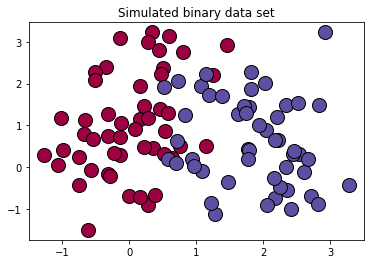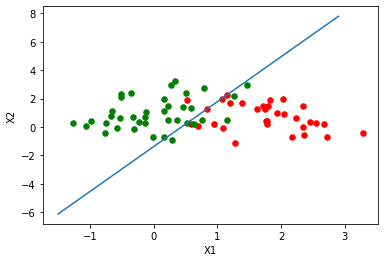chapter3——逻辑回归手动+sklean版本
1 导入numpy包
import numpy as np
2 sigmoid函数
def sigmoid(x):
return 1/(1+np.exp(-x))
demox = np.array([1,2,3])
print(sigmoid(demox))
#报错
#demox = [1,2,3]
# print(sigmoid(demox))
结果:
[0.73105858 0.88079708 0.95257413]
3 定义逻辑回归模型主体
### 定义逻辑回归模型主体
def logistic(x, y, w, b):
# 训练样本量
num_train = x.shape[0]
# 逻辑回归模型输出
y_hat = sigmoid(np.dot(x,w)+b)
# 交叉熵损失
cost = -1/(num_train)*(np.sum(y*np.log(y_hat)+(1-y)*np.log(1-y_hat)))
# 权值梯度
dW = np.dot(x.T,(y_hat-y))/num_train
# 偏置梯度
db = np.sum(y_hat- y)/num_train
# 压缩损失数组维度
cost = np.squeeze(cost)
return y_hat, cost, dW, db
4 初始化函数
def init_parm(dims):
w = np.zeros((dims,1))
b = 0
return w ,b
5 定义逻辑回归模型训练过程
### 定义逻辑回归模型训练过程
def logistic_train(X, y, learning_rate, epochs):
# 初始化模型参数
W, b = init_parm(X.shape[1])
cost_list = []
for i in range(epochs):
# 计算当前次的模型计算结果、损失和参数梯度
a, cost, dW, db = logistic(X, y, W, b)
# 参数更新
W = W -learning_rate * dW
b = b -learning_rate * db
if i % 100 == 0:
cost_list.append(cost)
if i % 100 == 0:
print('epoch %d cost %f' % (i, cost))
params = {
'W': W,
'b': b
}
grads = {
'dW': dW,
'db': db
}
return cost_list, params, grads
6 定义预测函数
def predict(X,params):
y_pred = sigmoid(np.dot(X,params['W'])+params['b'])
y_preds = [1 if y_pred[i]>0.5 else 0 for i in range(len(y_pred))]
return y_preds
7 生成数据
# 导入matplotlib绘图库
import matplotlib.pyplot as plt
# 导入生成分类数据函数
from sklearn.datasets import make_classification
# 生成100*2的模拟二分类数据集
x ,label = make_classification(
n_samples=100,# 样本个数
n_classes=2,# 样本类别
n_features=2,#特征个数
n_redundant=0,#冗余特征个数(有效特征的随机组合)
n_informative=2,#有效特征,有价值特征
n_repeated=0, # 重复特征个数(有效特征和冗余特征的随机组合)
n_clusters_per_class=2 ,# 簇的个数
random_state=1,
)
print("x.shape =",x.shape)
print("label.shape = ",label.shape)
print("np.unique(label) =",np.unique(label))
print(set(label))
# 设置随机数种子
rng = np.random.RandomState(2)
# 对生成的特征数据添加一组均匀分布噪声https://blog.csdn.net/vicdd/article/details/52667709
x += 2*rng.uniform(size=x.shape)
# 标签类别数
unique_label = set(label)
# 根据标签类别数设置颜色
print(np.linspace(0,1,len(unique_label)))
colors = plt.cm.Spectral(np.linspace(0,1,len(unique_label)))
print(colors)
# 绘制模拟数据的散点图
for k,col in zip(unique_label , colors):
x_k=x[label==k]
plt.plot(x_k[:,0],x_k[:,1],'o',markerfacecolor=col,markeredgecolor="k",
markersize=14)
plt.title('Simulated binary data set')
plt.show();
结果:
x.shape = (100, 2)
label.shape = (100,)
np.unique(label) = [0 1]
{0, 1}
[0. 1.]
[[0.61960784 0.00392157 0.25882353 1. ]
[0.36862745 0.30980392 0.63529412 1. ]]

复习
# 复习
mylabel = label.reshape((-1,1))
data = np.concatenate((x,mylabel),axis=1)
print(data.shape)
结果:
(100, 3)
8 划分数据集
offset = int(x.shape[0]*0.7)
x_train, y_train = x[:offset],label[:offset].reshape((-1,1))
x_test, y_test = x[offset:],label[offset:].reshape((-1,1))
print(x_train.shape)
print(y_train.shape)
print(x_test.shape)
print(y_test.shape)
结果:
(70, 2)
(70, 1)
(30, 2)
(30, 1)
9 训练
cost_list, params, grads = logistic_train(x_train, y_train, 0.01, 1000)
print(params['b'])
结果:
epoch 0 cost 0.693147
epoch 100 cost 0.568743
epoch 200 cost 0.496925
epoch 300 cost 0.449932
epoch 400 cost 0.416618
epoch 500 cost 0.391660
epoch 600 cost 0.372186
epoch 700 cost 0.356509
epoch 800 cost 0.343574
epoch 900 cost 0.332689
-0.6646648941379839
10 准确率计算
from sklearn.metrics import accuracy_score,classification_report
y_pred = predict(x_test,params)
print("y_pred = ",y_pred)
print(y_pred)
print(y_test.shape)
print(accuracy_score(y_pred,y_test)) #不需要都是1维的,貌似会自动squeeze()
print(classification_report(y_test,y_pred))
结果:
y_pred = [0, 0, 1, 1, 1, 1, 0, 0, 0, 1, 1, 1, 0, 1, 1, 1, 1, 1, 1, 0, 0, 1, 1, 0, 1, 1, 0, 0, 1, 0]
[0, 0, 1, 1, 1, 1, 0, 0, 0, 1, 1, 1, 0, 1, 1, 1, 1, 1, 1, 0, 0, 1, 1, 0, 1, 1, 0, 0, 1, 0]
(30, 1)
0.9333333333333333
precision recall f1-score support 0 0.92 0.92 0.92 12
1 0.94 0.94 0.94 18 accuracy 0.93 30
macro avg 0.93 0.93 0.93 30
weighted avg 0.93 0.93 0.93 30
11 绘制逻辑回归决策边界
### 绘制逻辑回归决策边界
def plot_logistic(X_train, y_train, params):
# 训练样本量
n = X_train.shape[0]
xcord1,ycord1,xcord2,ycord2 = [],[],[],[]
# 获取两类坐标点并存入列表
for i in range(n):
if y_train[i] == 1:
xcord1.append(X_train[i][0])
ycord1.append(X_train[i][1])
else:
xcord2.append(X_train[i][0])
ycord2.append(X_train[i][1])
fig = plt.figure()
ax = fig.add_subplot(111)
ax.scatter(xcord1,ycord1,s = 30,c = 'red')
ax.scatter(xcord2,ycord2,s = 30,c = 'green')
# 取值范围
x =np.arange(-1.5,3,0.1)
# 决策边界公式
y = (-params['b'] - params['W'][0] * x) / params['W'][1]
# 绘图
ax.plot(x, y)
plt.xlabel('X1')
plt.ylabel('X2')
plt.show()
plot_logistic(x_train, y_train, params)
结果:

11 sklearn实现
from sklearn.linear_model import LogisticRegression
clf = LogisticRegression(random_state=0).fit(x_train,y_train)
y_pred = clf.predict(x_test)
print(y_pred)
accuracy_score(y_test,y_pred)
结果:
[0 0 1 1 1 1 0 0 0 1 1 1 0 1 1 0 0 1 1 0 0 1 1 0 1 1 0 0 1 0]
0.9333333333333333
chapter3——逻辑回归手动+sklean版本的更多相关文章
- numpy+sklearn 手动实现逻辑回归【Python】
逻辑回归损失函数: from sklearn.datasets import load_iris,make_classification from sklearn.model_selection im ...
- 逻辑回归原理_挑战者飞船事故和乳腺癌案例_Python和R_信用评分卡(AAA推荐)
sklearn实战-乳腺癌细胞数据挖掘(博客主亲自录制视频教程) https://study.163.com/course/introduction.htm?courseId=1005269003&a ...
- 逻辑回归算法的原理及实现(LR)
Logistic回归虽然名字叫"回归" ,但却是一种分类学习方法.使用场景大概有两个:第一用来预测,第二寻找因变量的影响因素.逻辑回归(Logistic Regression, L ...
- Theano3.3-练习之逻辑回归
是官网上theano的逻辑回归的练习(http://deeplearning.net/tutorial/logreg.html#logreg)的讲解. Classifying MNIST digits ...
- PRML读书会第四章 Linear Models for Classification(贝叶斯marginalization、Fisher线性判别、感知机、概率生成和判别模型、逻辑回归)
主讲人 planktonli planktonli(1027753147) 19:52:28 现在我们就开始讲第四章,第四章的内容是关于 线性分类模型,主要内容有四点:1) Fisher准则的分类,以 ...
- Spark Mllib逻辑回归算法分析
原创文章,转载请注明: 转载自http://www.cnblogs.com/tovin/p/3816289.html 本文以spark 1.0.0版本MLlib算法为准进行分析 一.代码结构 逻辑回归 ...
- Python实践之(七)逻辑回归(Logistic Regression)
机器学习算法与Python实践之(七)逻辑回归(Logistic Regression) zouxy09@qq.com http://blog.csdn.net/zouxy09 机器学习算法与Pyth ...
- 学习Machine Leaning In Action(四):逻辑回归
第一眼看到逻辑回归(Logistic Regression)这个词时,脑海中没有任何概念,读了几页后,发现这非常类似于神经网络中单个神经元的分类方法. 书中逻辑回归的思想是用一个超平面将数据集分为两部 ...
- Andrew Ng机器学习课程笔记--week3(逻辑回归&正则化参数)
Logistic Regression 一.内容概要 Classification and Representation Classification Hypothesis Representatio ...
随机推荐
- leetcode1261在受污染的二叉树中查找元素
题目 一颗二叉树,树根值为0,父节点为x,则左子值为2x+1,右子为2x+2.现在只有树的结构,所有值都变为-1被污染了.求污染前是否存在某个值. 构建一次树,查询会调用多次. 题解 这道题还是比较简 ...
- Special Prime
Special Prime Time Limit: 2000/1000 MS (Java/Others) Memory Limit: 32768/32768 K (Java/Others)Tot ...
- 阿克曼函数推导过程(m<=3)
阿克曼函数(Ackermann)是非原始递归函数的例子.它需要两个自然数作为输入值,输出一个自然数.它的输出值增长速度非常快,仅是对于(4,3)的输出已大得不能准确计算. \[A(m, n)=\lef ...
- Learning a Similarity Metric Discriminatively, with Application to Face Verification
目录 概 主要内容 genuine 和 impostor 文1 文2 Chopra S, Hadsell R, Lecun Y, et al. Learning a similarity metric ...
- 浅谈MemoryCache的原生插值方式
.NET运行时内置了常用的缓存模块: MemoryCache 标准的MemoryCache暴露了如下几个属性和方法: public int Count { get; } public void Com ...
- CS5263|DP转HDMI转换器芯片|CS5263芯片说明
CS5263是一款高性能DP1.4到HDMI2.0b功能芯片,设计用于将DP1.4源连接到HDMI2.0b接收器.CS5263集成了DP1.4兼容接收机和HDMI2.0b兼容接收机发射器.DP接口包括 ...
- <数据结构>XDOJ324,325图的优先遍历
XDOJ324.图的广度优先遍历 问题与解答 问题描述 已知无向图的邻接矩阵,以该矩阵为基础,给出广度优先搜索遍历序列,并且给出该无向图的连通分量的个数.在遍历时,当有多个点可选时,优先选择编号小的顶 ...
- Eclipse远程调试Java代码的三种方法
Eclipse远程调试Java代码的三种方法, 第1种方法是用来调试已经启动的Java程序,Eclipse可以随时连接到远程Java程序进行调试, 第2种方法可以调试Java程序启动过程,但是Ecli ...
- 2 - 基于ELK的ElasticSearch 7.8.x技术整理 - java操作篇 - 更新完毕
3.java操作ES篇 3.1.摸索java链接ES的流程 自行创建一个maven项目 3.1.1.依赖管理 点击查看代码 <properties> <ES-version>7 ...
- 图解MySQL:count(*) 、count(1) 、count(主键字段)、count(字段)哪个性能最好?
大家好,我是小林. 当我们对一张数据表中的记录进行统计的时候,习惯都会使用 count 函数来统计,但是 count 函数传入的参数有很多种,比如 count(1).count(*).count(字段 ...
